#Treatment for Gross Hematuria
Explore tagged Tumblr posts
Text
The recommended Bladder Cyst Treatment will depend on the cyst's type and severity. If the cyst is small and not causing significant symptoms, monitoring with regular check-ups may suffice. For cases where cysts cause discomfort or complications, doctors may recommend draining the cyst or removing it surgically through minimally invasive procedures.
#Urology Experts Fort Myers#Bladder Cyst Treatment#Kidney Infection Peeing Blood#Bladder Cyst Treatment Fort Myers Fl#Treatment for Gross Hematuria#Treatment For Hematuria In Females Fort Myers Fl#Top Urology Doctors Near Me#Treatment for Hematuria in Females
0 notes
Text
Dear Diary. It started some years ago when I was living in TX. I had passed my first kidney stone and fuck it was not a pleasant experience. I was really high on the medication they gave me. I clearly remember that the nurse asked me how I was feeling. I told her that I was at 72K feet yet the pain was still at eleven or twelve. She was aghast and got up to the doctor. He came in and asked me the same questions. I’m sure he didn’t know what to think but he ordered something else for the IV. I leveled out and the pain went down to tolerable and then they sent me home. I got home, took 3 Advil Liquigels and a few hits of a joint and went to sleep.
Just recently I passed another kidney stone or two. Again nearly the same experience as before.
I went home and did some research on reputable sites and even the kidney foundation. I learned a lot. The processed foods that I was eating are a contributing factor in this equation. All the salt and sugar are the names of things that are nearly impossible to pronounce correctly are fucking up my kidneys.
I went to the urologist and he told me that more tests are required. The diagnosis is Gross Hematuria. Blood in my urine.
Some of things that are important to learn about these kidney stones is that they are not good. Possibly heart disease. Also prostate cancer, a family history. I know that it can be treated with surgery, a Transurethral Resection of The Prostrate and Radioactive Seeds. Then there are other treatments and surgeries.
Yet I’m conflicted.
I’ve never been so nervous. I’ve gone 99.9% vegan. I don’t cook with salt. I only put sugar in my coffee. Eating quinoa, wheat berry, lentils and other vegetables. It’s tough but I do it regardless.
As I contemplate my navel, I know I’ve been a douche bag and just an absolute jerk. I know that my life means nothing to you and my words have wounded you.
I am so sure that you will have nothing to say to me and now, you are on the precipice of getting your way and I’ve been trying to get to a point where I need to make a decision. Do I just roll with it and do all the things that my doctor suggests or do I ignore him? Peggy Lee once said, I’m not ready for that final disappointment.
I am.
I know that there plenty of words to describe me and I deserve them all and I will accept them all. I know that you are correct, I know nothing about your life. You know more about my life than anyone should because I am incapable of lying to you.
I’m not sure if you have seen my posts on Instagram but if you have, then you know.
Fuck. I’m sorry for existing.
2 notes
·
View notes
Text
What Does Blood in Urine Mean and Should I Be Worried?
Seeing blood in your urine, also known as hematuria, can be an unsettling experience. In some cases, it might be harmless, but it can also signal a more serious underlying condition. Understanding the potential causes and when to seek medical attention is crucial for your peace of mind and health.
Types of Blood in Urine
There are two main types of hematuria:
Gross hematuria: When blood is visible to the naked eye, making your urine look pink, red, or even cola-colored.
Microscopic hematuria: Blood is present in such small amounts that it can only be detected under a microscope during a urine test.
Whether gross or microscopic, finding blood in your urine should never be ignored, as it can sometimes indicate urinary tract issues or other more serious health concerns.
Common Causes of Blood in Urine
Blood in the urine can result from various conditions, ranging from minor to more serious. Some of the most common causes include:
Urinary tract infections (UTIs): These infections can cause inflammation in the bladder, leading to blood in the urine.
Kidney stones: Small, hard deposits can irritate the urinary tract as they pass, causing bleeding.
Bladder or kidney infections: Infections in these organs can also lead to visible or microscopic blood in the urine.
Prostate problems: In men, an enlarged or inflamed prostate can cause hematuria.
Strenuous exercise: In some cases, intense physical activity can lead to temporary blood in the urine.
Certain medications, foods (such as beets or rhubarb), and supplements can sometimes cause urine to change color, making it look red or pink. However, these changes are harmless and are not related to blood in the urine.
When to See a Doctor
If you notice blood in your urine, it's important to consult a healthcare provider. Even if you’re not experiencing pain, blood in your urine could be a symptom of a more serious condition, such as:
Bladder or kidney cancer
Kidney disease
Blood clotting disorders
Injury to the urinary tract
Seek immediate medical attention if your blood in the urine is accompanied by:
Pain in your side, abdomen, or back
Fever, chills, or nausea
Difficulty urinating or passing blood clots
These could be signs of a severe infection, kidney stone, or other urgent medical conditions.
Diagnosis and Treatment
To determine the cause of blood in your urine, your doctor may order several tests, such as a urinalysis, urine culture, or imaging tests like an ultrasound or CT scan. A physical exam and medical history will also help identify the cause.
Once the underlying cause of the hematuria is found, treatment can begin. In cases of urinary tract issues, for example, antibiotics may be prescribed to clear up an infection. If kidney stones are to blame, pain management and increased water intake may help pass the stones. More serious conditions may require additional treatments, such as surgery or ongoing monitoring.
Final Thoughts
Finding blood in your urine is concerning, but it’s not always a cause for alarm. Identifying the cause early and seeking the right treatment is key to preventing potential complications. If you notice any changes in your urine, it’s always best to consult with your healthcare provider to ensure the issue is addressed promptly and appropriately.
Staying informed and proactive about your health can help you avoid serious urinary tract issues and maintain your well-being.
0 notes
Text
When to Consider Consulting a Urologist: Signs It's Time for Expert Care
Introduction:
Maintaining optimal urological health is crucial for overall well-being, yet many individuals may hesitate to seek assistance from a urologist until symptoms become severe. Knowing when to consult a urologist can help address concerns promptly, leading to timely diagnosis and effective treatment. In this blog, we'll explore common signs and symptoms that indicate it's time to schedule an appointment with a urologist.
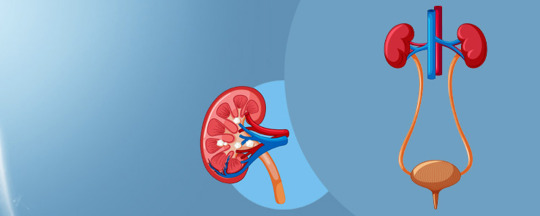
1. Persistent Urinary Issues:
Frequent or urgent urination, difficulty initiating or maintaining urination, and pain or discomfort during urination are all signs of potential urological problems. Conditions such as urinary tract infections (UTIs), bladder infections, kidney stones, and benign prostatic hyperplasia (enlarged prostate) can manifest with these symptoms. If you experience persistent urinary issues, it's advisable to seek evaluation by a urologist to determine the underlying cause and receive appropriate treatment.
2. Blood in Urine:
Hematuria, or blood in the urine, should never be ignored, as it can indicate various urological conditions, including urinary tract infections, kidney stones, bladder cancer, and kidney cancer. Whether the blood is visible to the naked eye (gross hematuria) or detected through microscopic analysis (microscopic hematuria), it warrants prompt evaluation by a urologist to rule out serious underlying pathology.
3. Erectile Dysfunction:
Erectile dysfunction (ED) is a common condition that can significantly impact quality of life and intimate relationships. While occasional episodes of ED are normal, persistent difficulties achieving or maintaining an erection may indicate an underlying health issue, such as cardiovascular disease, diabetes, or hormonal imbalance. Consulting a urologist can help identify the cause of ED and explore appropriate treatment options, which may include medications, lifestyle modifications, or specialized therapies.
4. Testicular Abnormalities:
Changes in the size, shape, or consistency of the testicles should be evaluated by a urologist, as they can be indicative of conditions such as testicular cancer, epididymitis (inflammation of the epididymis), or hydrocele (fluid accumulation around the testicle). Prompt assessment and diagnosis are crucial for timely intervention and optimal outcomes, particularly in the case of testicular cancer, which has high cure rates when detected early.
5. Prostate Health Concerns:
Men over the age of 50, and those with a family history of prostate cancer, should consider regular prostate screenings, including digital rectal exams (DRE) and prostate-specific antigen (PSA) tests. Symptoms such as frequent urination, difficulty urinating, blood in the semen, or persistent pelvic pain may also warrant evaluation by a urologist to assess prostate health and rule out conditions such as prostatitis or prostate cancer.
6. Infertility Issues:
Couples experiencing difficulty conceiving may benefit from consultation with a urologist specializing in male infertility. Factors such as low sperm count, abnormal sperm morphology, or obstructive issues within the reproductive tract can contribute to infertility in men. A urologist can perform comprehensive evaluations, including semen analysis and hormonal testing, to identify potential causes of infertility and recommend appropriate interventions or assisted reproductive techniques.
Conclusion:
Knowing when to seek guidance from a urologist is essential for addressing urological concerns in a timely manner and optimizing health outcomes. Whether experiencing urinary symptoms, sexual dysfunction, testicular abnormalities, or fertility issues, consulting a urologist can provide valuable insights, diagnosis, and personalized treatment plans tailored to individual needs. Prioritizing urological health through proactive care empowers individuals to lead healthier, more fulfilling lives.
0 notes
Text
0 notes
Text
Understanding Hematuria: Blood in Urine
The presence of blood in urine, a condition known as hematuria, can be a concerning symptom that may indicate an underlying medical issue. There are two primary types of hematuria: gross hematuria, where blood is visible in the urine, and microscopic hematuria, where blood can only be detected under a microscope.
Causes and Concerns
Hematuria can arise from various factors, ranging from minor to severe. Common causes include urinary tract infections, kidney stones, strenuous exercise, trauma to the urinary tract, and certain medications. However, it can also signal more serious conditions such as kidney disease, bladder cancer, or prostate problems.
Diagnostic Process
When hematuria is detected, it is essential to undergo further evaluation to determine the underlying cause. This typically involves a series of diagnostic tests, including urine tests, imaging studies (such as ultrasound or CT scan), and possibly a cystoscopy (a procedure to examine the bladder and urethra with a small camera).
Treatment and Management
The treatment of hematuria depends on the underlying cause. Once the cause is identified, a healthcare professional will develop a tailored treatment plan. For example, if a urinary tract infection is the culprit, antibiotics may be prescribed. Similarly, medications or procedures may be recommended for conditions like kidney stones or bladder tumors.
Seeking Prompt Medical Attention
It is crucial to seek medical attention promptly if you notice blood in your urine, even if it resolves on its own or if you experience no other symptoms. Early detection and appropriate treatment can help manage and address the underlying cause, potentially preventing complications and improving outcomes.
Final Note
This information serves as an educational overview of hematuria and should not replace professional medical advice, diagnosis, or treatment. Always consult with a healthcare provider for concerns about your health. By being proactive about your urinary health and seeking timely medical attention when needed, you can take steps to safeguard your well-being and address any potential underlying issues effectively.
1 note
·
View note
Text
When to Visit a Urologist

Urological health is a fundamental aspect of overall well-being, but many individuals may not be aware of the signs and symptoms that warrant a visit to a urologist. Urologists are medical specialists trained to diagnose and treat a wide range of conditions affecting the urinary and reproductive systems in both men and women. Understanding when to consult a urologist is essential for maintaining urological health, preventing potential complications, and addressing concerns early. The following are some key signs and conditions that indicate the need for a urologist's expertise.
Frequent urination, known as urinary frequency, can be a sign of various urological issues. If you find yourself needing to urinate more often than usual, particularly if it disrupts your daily activities or disturbs your sleep, it may be an indicator of an underlying problem. Common causes of frequent urination include urinary tract infections (UTIs), bladder conditions like overactive bladder (OAB), diabetes, and an enlarged prostate (in men).
A urology doctor can help determine the cause of your urinary frequency and recommend appropriate treatment, which may include lifestyle modifications, medications, or surgery.
Experiencing pain, discomfort, or a burning sensation during urination is often a sign of a urinary tract infection (UTI). UTIs can affect both men and women and typically require prompt medical treatment to prevent the infection from spreading to the kidneys.
In some cases, pain during urination can be indicative of other conditions, such as sexually transmitted infections (STIs) or bladder inflammation. If you experience these symptoms, it is advisable to consult a urology doctor for a proper diagnosis and treatment.
Hematuria, or the presence of blood in the urine, is a concerning symptom that should prompt a visit to a urologist. Blood in the urine can be visible to the naked eye (gross hematuria) or detected only under a microscope (microscopic hematuria). It may indicate various conditions, including urinary tract infections, kidney stones, bladder or kidney cancer, and benign prostate conditions (in men).
A urologist can perform diagnostic tests to determine the underlying cause of hematuria and recommend appropriate treatment or surveillance based on the diagnosis.
For more signs you need to visit a urologist, visit our website at https://nowserving.ph/
0 notes
Text
North America Hematuria Treatment Market Competitive Insights, Production Overview and Forecast 2028
“The North America hematuria treatment market is projected to reach US$ 419.7 million by 2028 from US$ 351.6 million in 2021; it is anticipated to grow at a CAGR of 2.6% from 2021 to 2028.”
The report includes an executive summary, economic outlook, and overview sections which provide a consistent analysis of the North America Hematuria Treatment market. Additionally, the report in the Market overview section outlines PLC analysis and PESTLE analysis to provide a thorough analysis of the market. The overview section details Porter’s five forces analysis which helps to reveal a possible scenario of the market by disclosing a competitive scenario with respect to the North America Hematuria Treatment Market.
To Get a Sample Copy of the Report, Click Here:
https://www.businessmarketinsights.com/sample/TIPRE00026252
Top companies in the North America Hematuria Treatment Market are –
AstraZeneca
Bristol-Myers Squibb Company
HOFFMANN-LA ROCHE LTD.
GlaxoSmithKline plc.
Janssen Pharmaceuticals
Merck & Co., Inc.
Novartis AG
Pfizer Inc.
Sun Pharmaceutical Industries Ltd
Boehringer Ingelheim International GmbH
The major players in the North America Hematuria Treatment industry is covered in this report by report, their market share, product portfolio, company profiles. Key market players are analyzed on the basis of production volume, gross margin, market value, and price structure. The competitive market scenario among North America Hematuria Treatment players will help the industry aspirants in planning their strategies. The statistics presented in this report are an accurate and useful guide to shaping your business growth.
Market Segment by Type, the product divided into:
Macroscopic Hematuria
Microscopic Hematuria
Idiopathic Hematuria
Jogger’s Hematuria
Market Segment by Application, split into:
Hospitals
Clinics
Ambulatory Surgical Centers (ASC’s)
Others
Purchase a Copy of this North America Hematuria Treatment Market research report at @
https://www.businessmarketinsights.com/buy/single/TIPRE00026252
Table of Content for North America Hematuria Treatment Market Research Report:
Chapter 1: Industry Overview
Chapter 2: North America Hematuria Treatment Market International and Regional Market Analysis
Chapter 3: Environment Analysis of Market.
Chapter 4: Analysis of Revenue by Classifications.
Chapter 5: Analysis of Revenue by Regions and Applications.
Chapter 6: Analysis of North America Hematuria Treatment Market Revenue Market Status.
Chapter 7: Analysis of Industry Key Manufacturers
Chapter 8: Sales Price and Gross Margin Analysis of Market.
Chapter 9: ……………………. Continue to TOC
Finally, North America Hematuria Treatment Market report is the believable source for gaining the Market research that will exponentially accelerate your business. The report provides locales, economic conditions, item values, benefits, limits, creations, supplies, requests, market development rates, and numbers, etc. North America Hematuria Treatment industry report announces additional new task SWOT examination, and speculation achievement investigation and venture return investigation.
About Us:
Business Market Insights is a market research platform that provides subscription services for industry and company reports. Our research team has extensive professional expertise in domains such as Electronics & Semiconductor; Aerospace & Defense; Automotive & Transportation; Energy & Power; Healthcare; Manufacturing & Construction; Food & Beverages; Chemicals & Materials; and Technology, Media, & Telecommunications.
Contact Us:
If you have any questions about this report or would like further information, please contact us:
Contact person: Sameer Joshi
Phone: +16467917070
Email: [email protected]
Web URL: https://www.businessmarketinsights.com
0 notes
Text
Needle Tract Recurrence of Renal Cell Carcinoma after Microwave Ablation by Tella David in Journal of Clinical and Medical Images, Case Reports

Abstract
A 21 years-old male was complaining from; decrease in vision, fever, blurring and inability to open the eyes in the sun. The patient attended the Eye hospital in Gaza where Fundus photo and serological tests were carried out in the eye hospital and Islamic University-Gaza laboratories. The patient complains from blurring and retinochoroditis. The ophthalmological examination revealed hypertensive non-granulomatous panuveitis, retinal vasculitis with focus of retinochoroiditis with lesioned central area suggestive of ocular toxoplasmosis. The serological tests proved that IgG was high in the patient serum and recorded 54.50 while IgM was negative. The fundus photo showed a clear lesion. Ocular toxoplasmosis is present among patients attending Eye hospital. The clinical cases could be detected among patients complaining from retinochoroditis. Ocular toxoplasmosis should be considered, and more investigations are needed. Keywords: Ocular; toxoplasmosis; fundus; eye; Gaza; infection.
Introduction
Thermal ablation is commonly used for management of small renal masses. Tumor seeding due to needle manipulation during renal mass biopsy or thermal ablative treatment is very rare. Seeding upstages a curable, organ-confined disease into a complicated recurrent cancer. This condition is described in few case reports and has not been reported after microwave ablation [3]. We report a patient that underwent transhepatic microwave ablation of a right renal cancer and developed a tumor along the ablation tract.
Case report
A 75-year-old male with complex medical history including heart disease, hypertension, chronic kidney disease, and sleep apnea presented to our clinic with a 4 cm right renal mass discovered incidentally following CT imaging for unrelated abdominal pain (Figure 1). A biopsy of the mass revealed a Fuhrman grade 2 clear cell renal cell carcinoma (RCC). Treatment options were discussed and the patient elected microwave ablation therapy. This procedure was performed by a urology and radiology collaborative team.

Figure 1: Preoperative CT showing right upper pole kidney tumor (thin arrow) and adjacent cyst (thick arrow).
Three PR -15 (NeuWave Medical, Madison, WI) microwave probes were inserted transhepatically into the upper pole renal tumor. Correct positioning of the probes within the mass was confirmed with ultrasound and abdominal CT scan (Figure 2). Immediate post procedure films showed complete ablation of the tumor and the adjacent cyst. Significantly, the entire trans-hepatic tract was ablated during removal of the microwave probes, as is our protocol.

Figure 2: Transhepatically placed microwave probes traversing the posterior aspect of the liver (arrow) with tips located in the right renal mass.
Six months later, the patient underwent a surveillance CT scan which demonstrated no tumor recurrence (Figure 3). MRI imaging at year 2 demonstrated stable post-treatment changes of right upper pole kidney ablation, without evidence of tumor recurrence or metastasis.
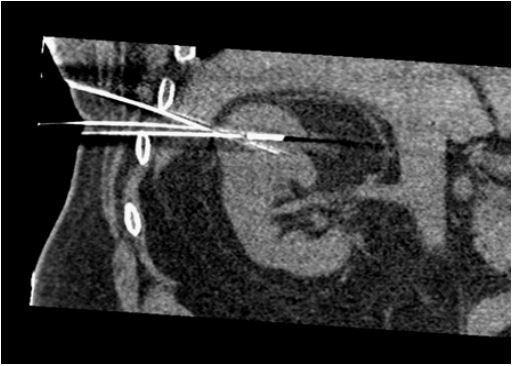
Figure 3: Coronal oblique CT reconstruction showing path of probes through liver edge.

Figure 4: US during ablation showing probe tract through liver edge.
Five years following ablation, the patient presented with gross hematuria and right flank pain. A CT urogram demonstrated a filling defect in the proximal right ureter. Additionally, there was an ill-defined hypo-enhancing lesion at the posterior right hepatic lobe with an adjacent small perihepatic soft tissue nodule, not present on prior studies (Figure 4). The patient underwent right ureteroscopy. Upon entry into the bladder, blood was effluxing from the right ureteral orifice. Ureteroscopy revealed old clot in renal pelvis, but no tumors or active bleeding. Urine cytology was negative for malignancy.
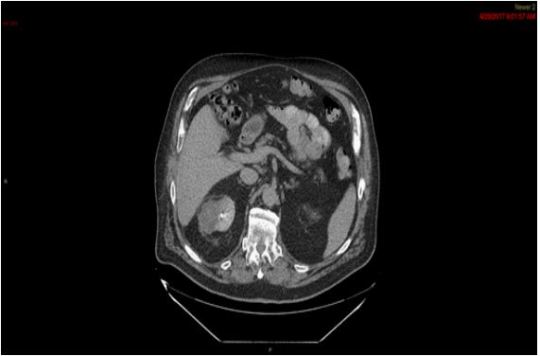
Figure 5: Six month post ablation CT showing non-enhancing right upper pole mass. Liver appears normal.
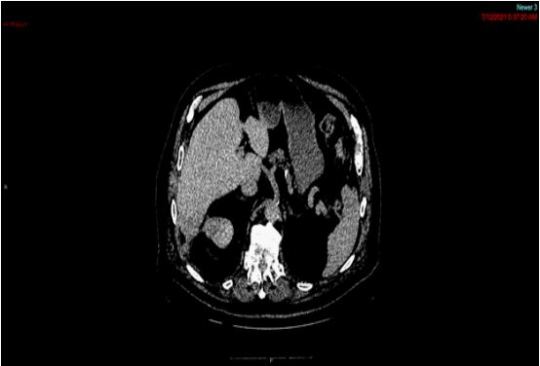
Figure 6: Five year post ablation image showing liver mass (hollow arrow), perihepatic mass (thin arrow), and enhancing upper pole renal mass (arrowhead).
The patient was referred for ultrasound guided percutaneous biopsy of the liver mass. The biopsy revealed metastatic carcinoma, favored to be renal cell carcinoma. Metastatic workup with a chest CT demonstrated scattered (approximately 15) sub-centimeter pulmonary nodules suspicious for metastatic disease. A review of the CT showed 2 cm recurrence of the right upper pole renal mass. The patient has been evaluated by medical oncology and is currently on an active surveillance protocol for his asymptomatic metastatic disease.
Discussion
Percutaneous thermal ablation has been described to be effective in the management of appropriately selected cases of RCC. Few reports of metastasis in the ablation tract after treatment have been published [1, 2]. Metastasis following ablation is suspected to be caused by tumor spillage during cryoablation or during withdrawal of the probe at the end of ablation [3]. Accumulated anecdotal cases note that transhepatic access to the upper pole of the kidney can be performed safely in the rare cases where no other access is possible [4, 5].
Some reports suggest transhepatic radiofrequency ablation can be an advantageous approach for superior or anterior renal masses, especially in patients that are unable to undergo ablation in the prone position [4, 5]. The main disadvantage identified is the violation of the peritoneum, which portends increased risk of seeding. It is estimated that such seeding is a very rare, occurring in <0.01% of cases. These reports discuss tract ablation to mitigate this risk; however, the benefit of this approach is not well defined. To our knowledge, metastasis to the liver following a transhepatic approach has not been previously described after percutaneous microwave ablation of RCC. In the case of our patient, this was an anterior, superior mass. However, this recurrence occurred despite our careful ablation of the liver tract at the end of the procedure.
Conclusions
Seeding metastasis is an unfortunate and rare event, which can occur after percutaneous ablation of a renal mass. We caution all clinicians to avoid transhepatic access for percutaneous ablation of a renal mass, when feasible, to avoid possible hepatic seeding metastasis.
For more details : https://jcmimagescasereports.org/author-guidelines/
#Ocular#toxoplasmosis#fundus#eye#Gaza#infection#hypertensive#panuveitis#retinochoroditis#renal cell carcinoma#hypo-enhancing#Tella David#JCMICR
0 notes
Text
Why Would You Need to Consult a Urologist?
Urologists deal with health issues that involve the urinary tract and the male reproductive system. They also treat conditions that affect the adrenal glands.
Men often seek a urologist for blood in their urine, urinary incontinence, or an elevated prostate-specific antigen (PSA). Prostate cancer is another common reason men see a urologist.
If you see blood in your urine, you must visit a urologist. Most hematuria is benign, but it can be a warning sign of a severe condition.
The kidneys filter blood to produce urine, which is made up of waste products and extra water. It then passes through the tubes called ureters to the bladder, where it is stored until urination occurs.
Sometimes, the urine is pink, red, or tea-colored (gross hematuria). In other cases, it is hard to spot blood in the urine with the naked eye.
Doctors usually perform a physical exam to look for bleeding and check the kidneys, ureters, and bladder. They will also order tests to help find the source of the hematuria and treat it. These include a urinalysis and an intravenous pyelogram.
Urinary incontinence is a common problem that affects millions of men and women. However, many people don’t see a doctor because they are embarrassed or think nothing can be done.
A urologist can help you get to the bottom of your incontinence and find solutions that work for you. Usually, they begin by asking you questions about your symptoms and the type of incontinence you have.
Your doctor will also ask about your medical history and perform a physical exam. This includes looking at your pelvic area for any signs of a problem, checking your prostate, and performing a pelvic ultrasound or renal ultrasound.
The doctor may also ask you to keep a bladder diary. This involves recording when you urinate, how much you urinate, and whether you have any incontinence episodes.
If you have pelvic pain, it could indicate an underlying medical condition. It can be challenging to pinpoint the cause of pelvic pain, but if you see a urologist, it could lead to a better diagnosis and treatment.
A urologist is a specialist doctor who treats conditions that affect both the urinary and reproductive systems. They may have to do tests, such as blood work or an X-ray, to diagnose the source of your pain.
For example, if your symptoms suggest that you have interstitial cystitis (IC), a urologist can do a cystoscopy, which uses a particular scope to look inside your bladder. Your urologist can also do other tests to rule out possible causes of your pelvic pain.
If you have difficulty achieving and maintaining an erection firm enough to allow sexual intercourse, you may need a consultation with a urologist. They specialize in disorders of the urinary tract and male reproductive system, so they can be an excellent resource for treating erectile dysfunction.
Your urologist will discuss your medical history and ask questions about sexual activity. They will also perform a physical examination to determine the cause of your ED.
Many times erectile dysfunction is the result of an underlying health problem, such as diabetes or low testosterone levels. Treating these conditions usually reverses ED.
Other times erectile dysfunction is a symptom of a more severe condition, such as vascular disease (hardening of the arteries). This can be treated by your GP or by taking medication.
Psychological issues, such as depression and stress, can also cause erectile dysfunction. These issues can lead to poor self-esteem and anxiety.
1 note
·
View note
Text

Discover advanced Treatment For Hematuria In Females Fort Myers Fl at Urology Experts, where we specialize in addressing urinary tract issues and hematuria. Our experienced team offers comprehensive diagnostics and personalized treatment plans to ensure optimal outcomes for female patients dealing with hematuria or related symptoms. Visit us today to learn more about our tailored care services.
#Treatment For Hematuria In Females#Kidney Infection Peeing Blood#Treatment For Hematuria In Females Fort Myers Fl#Treatment for Gross Hematuria#Bleeding Urinary Tract
0 notes
Photo

Anti-glomerular basement membrane (GBM) disease was previously called Goodpasture disease. Anti-GBM is a rare condition characterized by acute glomerulonephritis and pulmonary alveolar hemorrhage. This condition is also referred to as a pulmonary-renal syndrome. The most common presentation is hemoptysis or cough in the presence of gross hematuria. Look for the presence of anti-GBM antibodies. Treatment includes plasma exchange and immunosupression with corticosteroids and cyclophosphamide
2 notes
·
View notes
Text
Hematuria Treatment Market 2021-2027 High Key Players For Market, Application, Product Sort, Statement
Hematuria Treatment Market Overview :
The hematuria treatment market is accruing rapidly mainly due to the increasing number of bladder or kidney stones; kidney disease; urinary tract infection, cystitis (bladder infection), or pyelonephritis (kidney infection); cancers of the urinary tract (kidney, bladder, prostate); trauma, injury, or urinary tract instrumentation; rigorous exercise; benign prostatic hyperplasia; and blood thinners for such as Antithrombotic medications.
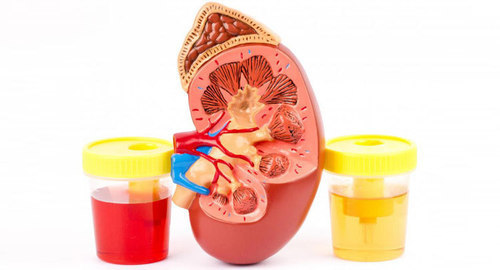
In addition to the chronic diseases, infection or diseases are too impacting the market growth positively. At the same time, there are various treatments and novel medications available for hematuria management which are pushing up the market on the global platform.
Acknowledging the colossal growth, the market is witnessing currently, Market Research Future (MRFR) in its recently published study report asserts that the global hematuria treatment market will grow exponentially by 2023 accruing at a striking CAGR during the forecast period (2018 – 2023).
Furthermore, technological advancements transpired in the field of hematuria management and advent treatment materials are fostering the market growth of hematuria treatment to an extent.
On the other hand, factors such as the complications in the treatment, high cost of product developments, and stringent regulations for approvals are expected to obstruct the market growth during the assessment period. Also, the pending or imminent patent expiries of many blockbuster hematuria management drugs are some hampering the market growth.
Nevertheless, factors like the instigation of a large number of regulatory healthcare reforms, developments of methods for the improved diagnosis and treatments for hematuria are expected to support the market growth bringing about the hematuria management therapeutics and treading along a promising increase in the next few years.
Hematuria Treatment Market – Segments :
The MRFR analysis is segmented into five key dynamics for the convenience of understanding;
By Type : Gross/ Macroscopic Hematuria, Microscopic Hematuria, Idiopathic Hematuria, and Jogger’s Hematuria.
By Causes : Kidney Stones, Urinary Tract Infections (UTI), Urethritis, Blood Cancer, Bladder Stones, Prostate Cancer, Cystitis, Trauma, Vigorous Exercise, Polycystic Kidney Disease, Endometriosis, and Menstruation.
By Treatment : Drugs and Therapeutics, among others.
By End-user : Hospitals, Clinics, and Labs among others.
By Regions : North America, Europe, APAC, and the Rest-of-the-World.
Get Free Sample of This Report at : https://www.marketresearchfuture.com/sample_request/1732
Hematuria Treatment Market – Regional Analysis :
The North American region dominates the global hematuria treatments market. The growing prevalence of kidney diseases, bladder cancer, and others along with the high per capita healthcare expenses drive the growth in the regional market.
Some of the factors such as the increasing technological innovations in medical science and the growing investments into R&D to develop new techniques to treat hematuria are substantiating market growth.
Besides the high consumption of antibiotics in the treatment of various chronic diseases, the presence of a well-established healthcare system, and rising cases of trauma & accidents foster the growth of the hematuria management market in the region.
Europe hematuria treatment market stands at the second position in terms of the size. The market in this region exhibits a phenomenal growth prospect throughout the review period.
Furthermore, factors like financial support from the government for R&D activities, and the increasing demand for hematuria treatments & devices drive the market growth in the region. Besides, the rising incidences of accidental injuries are contributing to the market growth in this region, generating a massive demand for the management of hematuria.
The Asia Pacific hematuria treatment market is emerging as a profitable market. Factors such as the increasing healthcare expenditure and increasing prevalence of hematuria led by the growing incidences of infections related to the urinary tract, bladder, and kidney drive the growth of the hematuria treatment market in the region.
The increasing governmental funding alongside a large unmet needs presages towards the growth opportunities for the market players. Spreading awareness about the availability of different hematuria management procedures is accelerating the market growth in the region. Besides, the availability of low-cost, quality hematuria management methods drives the regional market.
Hematuria Treatment Market – Competitive Analysis :
The highly competitive hematuria treatment market appears fragmented owing to a number of players and the increasing investments made by them in R&D activities in the hematuria management. Through the strategic partnership, acquisition, expansion, product & technology launch, and collaboration, these players try to gain a competitive edge.
Hematuria Treatment Market Key Players :
Some of the leaders of the market include Bristol-Myers Squibb, AstraZeneca Plc., F. Hoffmann-La Roche Ltd., Janssen Pharmaceuticals, Inc., GlaxoSmithKline Inc., Merck & Co., Sun Pharmaceutical Industries Limited, Novartis International AG, Pfizer, Inc., and The Medicines Company among others.
Industry/Innovation/Related News :
January 22, 2018 – Researchers at the Sunnybrook Health Sciences Centre’s Division of Urology (Canada) published the result of their study to investigate or manage hematuria in the Journal of the American Medical Association. Researchers examined the rate of hematuria-related complications in over 800,000 elderly patients. And, found that Antithrombotic medications, commonly known as blood thinners are associated with significant adverse events such as blood in the urine (hematuria) or the bleeding within the skull and stomach/ intestines as these drugs allow blood to flow easier throughout the cardiovascular system.
Browse Full Report with TOC at : https://www.marketresearchfuture.com/reports/hematuria-treatment-market-1732
#HematuriaTreatmentresearchreports#HematuriaTreatmentmarketsize#HematuriaTreatmentindustryanalysis#HematuriaTreatmentmarketanalysis#HematuriaTreatmentmarketresearch#HematuriaTreatmentmarket
1 note
·
View note
Text
Overcoming Hematuria With Ayurveda
Your fist-sized kidneys that sit at the back of your lower abdomen are the primary supporting structures of the urinary system that also include ureters, bladder, and urethra to complete the blood purification process of your body. They are nature's best purifiers that perform filtration and cleanses your blood from waste products, pollutants, and other excessive substances that are required to be expelled out from the body via urine.
But your kidneys are not only just limited to purify your blood; they also perform some other pertinent roles which are undeniably important to keep you alive. Let's have a look at what are those functions which makes kidneys a remarkably intricate organ of your body:-
They release certain hormones which control your blood pressure
They produce an active form of vitamin D that keeps your bones strong and healthy
They regulate the production of red blood cells in your body
They remove cell acid that is produced by the cells of your body.
They balance the level of potassium, phosphorus, calcium, and magnesium, and calcium in your body.
They balance the level of fluid in your body.
But certain biological stresses can toll on your kidneys' functioning and can also lead to a permanent loss of your kidneys. Several different kinds of renal ailments have different signs or symptoms and require different medications to reverse your kidneys' functioning.
Having blood in urine is one of the commonest chronic kidney diseases, which is termed hematuria. Let's dig a little deeper into this term "hematuria", its causes, and symptoms that come along with it.
What is Hematuria?
Blood in urine in medical terms is also termed hematuria, which indicates a serious potential threat heading towards your kidneys or in another part of the urinary tract. Hematuria is classified into two different types:
Gross hematuria, a condition in which you see blood in the urine. If you have lightish pink or cola-colored urine, then it indicates blood in the urine.
Microscopic hematuria is a condition in which blood is not visible to the naked eyes but can be seen under a microscope.
Who Can Develop Hematuria?
If you're in your 20s and are in denial that it can't happen to you, then you're wrong. Hematuria can equally happen to people of all ages, gender, caste, and races. But you're at higher risk if you:-
Recently have had an infection
Have a family history of kidney problems
Are consuming medicines, such as painkillers, antibiotics, and blood thinners
Do strenuous workout
Have an enlarged prostate
What Causes Bloody Urine?
Bloody urine can be a primary symptom of kidney disease, which majorly occurs when your body has only left with only 30 to 40% of kidneys' functioning. Here we've listed some commonly reported health conditions that trigger hematuria, includes the following-
Urinary tract infection
Monthly menstrual cycle in women which is normal
Kidney disease
kidney trauma
Kidney cancer
Bladder cancer ( mostly reported in smokers)
Enlarged prostate in older men
Strenuous workout session
Consumption of anti-swelling drugs
Prostate infection
How to Diagnose Hematuria?
Blood in the urine mainly occurs when your kidneys lose half of their functioning with time. The symptoms of hematuria mainly occur when the problems get severe with time and are hard to control with routine medications. Therefore, it's advised to get your urine and blood samples tested every year to monitor your kidneys' threat and eliminate the threat in time if there's any.
Ayurvedic Treatment for Hematuria
Ayurveda offers several combinations of cleansing and rejuvenation natural therapies that effectively perform internal purification and help your body to get rid off of toxins and waste products which, if remains inside for a longer period, can trigger serious health conditions such as high blood pressure, heart disease, brain tumor, stroke, and irreversible kidney disease. The blood in urine treatment in Ayurveda is based on the holistic approach that uses the complex of several powerful herbs, leaves, and fruits to cure any type of kidney problem ranging from mild to severe ones.
From the Ayurvedic point of view, kidney problems mainly occur when your dosha ( Vata, pitta, and Kapha) get disrupted and stirs up kidney problems. The blood in urine treatment in Ayurveda gradually brings balance to the aggravated doshas and helps you to attain overall holistic health.
1 note
·
View note